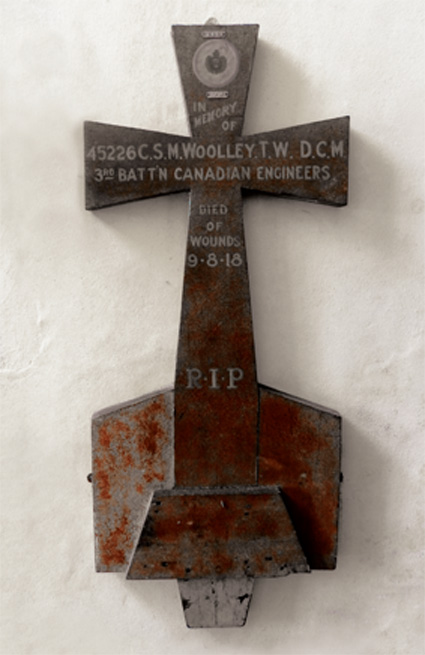Thomas Woolley was born in Eltham, London, on 6th March 1890, youngest son to George and Annie (née Durling). In 1891, the family were living at The Stable, 93 Devonshire Road in Lewisham. Ten years later, they had moved to Melton, where George found work as a coachman for James Burness of The Lodge. The Woolleys lived in the Lodge Gate Cottage on Yarmouth Road. At this time, Thomas was still of school age and attended Melton Council School.
In 1910, Thomas emigrated to Canada, setting sail on The Tunisian, arriving in Quebec on 2nd September; he stated that he intended to find work as a carpenter in Toronto.
Shortly after war broke out in Europe, Thomas joined in the Canadian Expeditionary Force at Valcartier Camp in Quebec, passing a medical on 9th September 1914 and formally enlisted on 24th September. As a skilled carpenter, he was posted to join the 3rd Field Company Canadian Engineers, part of the 1st Canadian Division. On 3rd October 1914, nine days after enlisting, Thomas boarded the SS Zealand for the journey across the Atlantic to England, arriving on the 14th. On 20th October, Thomas and the 3rd Field Company were encamped on Salisbury Plain undergoing training.
On 12th February 1915, Thomas and his field company disembarked in St Nazaire and entrained for billets in Hazebrouck. By the end of February, the 3rd Field Company had moved to Armentieres, where they were attached to the 38th Field Company Royal Engineers for instruction, before being allocated an area of the front line at Sailly-Sur- La-Lys. On 23rd March, the field company suffered their first casualty, when Sapper William Shaw died from shrapnel wounds received while working on the front line.
During the rest of 1915, the 3rd Field Company and Thomas were involved in the Second Battle of Ypres, the Battle of St Julien, and the Battle of Festubert. In 1916, their battle honours included the Battle of Pozieres and the Battle of Ancre Heights, both fought during the Battle of The Somme.
In October 1917, Thomas and the 3rd Field Company were based in billets at Poljize in the Ypres salient. At the end of the month, during the Second Battle of Passchendaele, the battalion was building a plank road across the mud to replace the old road between Spree Farm and Kansas Farm Crossroads – a distance of about a mile. On the 30th October the Battalion War Diary records:
“Half Company employed on PANET PLANK ROAD. Remainder improving Camp. Lieut A L Cummings wounded in forward area at night and evacuated. One OR killed in forward area.”
This was only half the story; for his actions on that night, Thomas was awarded the Distinguished Conduct Medal. His medal citation in the 28th March 1918 edition of the London Gazette reads:
“For conspicuous gallantry and devotion to duty while working on a plank road. His section officer was wounded, and the working party dispersed after suffering severe casualties. With great coolness and courage, he remained at work, collected the wounded, and reorganised the working party. He gave a splendid example to all with him.”
It was not until July 10th 1918, while in billets at Gauchin-Le-Gal, near Arras, that Company Sergeant Major Thomas Woolley received the ribbon confirming his award. In August, the battalion moved south towards Amiens where they were deployed building roads for the artillery to cross. On the 8th August, the first day of the Battle of Amiens, the battalion war diary says:
“operations carried out as per OOs (Operational Orders). “A” and “C” companies went over the front line at Zero (4:20 am) plus 30mins (4:50 am) and carried out work on track. “A” Company worked on “B” track over which artillery and guns passed at 6:10 am. “C” Company worked on “C” track over which artillery passed at 7 am. “D” Company carried out reconnaissance of dugouts and stabilised themselves there. “B” Company moved from Bois-de-Boves during afternoon and later to Aubercourt. Strength Decrease: Casualties: Capt. C A Bell, Capt. A L Cavanagh, A/CSM T W Woolley, Sgt A W McCloud and 5 other ORs wounded and evacuated. CSM Woolley and Sgt McCloud and one OR later died of their wounds.”
On being wounded, Thomas was evacuated to No.5 Casualty Clearing Station based at Proyart on the Somme where, on the same day, he died of his wounds. He is buried at Crouy British Cemetery, Crouy sur Somme.
Annie and George continued to live in the Melton area until their deaths in 1931 and 1935 respectively. They are buried at Melton Old Church.

